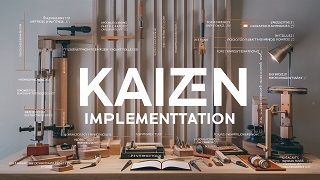
Achieving Big Results with Kaizen in Business
In today’s dynamic business landscape, staying competitive requires constant evolution. While disruptive innovations grab headlines, it’s often the power of small, incremental improvements that pave the way for lasting success. Enter Kaizen, a Japanese philosophy meaning “Change for the Better” or “Continuous Improvement.”
Kaizen: A Mindset, Not a One-Time Fix
Kaizen isn’t a one-off initiative, but a holistic philosophy embedded within an organization’s culture. It thrives on five core principles.
- Continuous Improvement: Every aspect of a business, from production lines to customer service calls, holds potential for betterment.
- Employee Empowerment: Kaizen encourages all employees, regardless of position, to identify inefficiencies and propose solutions. Everyone has valuable insights to contribute.
- Small, Incremental Changes: Focusing on achievable tweaks that are readily implemented allows for faster iteration and adaptation.
- Data-Driven Decisions: Kaizen relies on data and measurement to track progress, identify areas needing further improvement and assess the impact of changes.
- Standardization: Once an improvement proves effective, it becomes the new standard, ensuring consistency and quality across the organization.

Benefits of Embracing Kaizen
The advantages of implementing Kaizen are far-reaching.
- Increased Efficiency and Productivity: Streamlined workflows and reduced waste lead to doing more with less.
- Improved Quality: A continuous improvement focus leads to a culture of quality control, resulting in fewer errors and a higher quality product or service.
- Enhanced Employee Engagement: Empowering employees to contribute to improvement fosters a sense of ownership and increases morale. They become invested in the organization’s success.
- Reduced Costs: Eliminating waste and inefficiencies translates to cost savings across the board.
- Increased Innovation: A culture of continuous improvement encourages employees to think creatively and explore new ideas, fostering a spirit of innovation.
- Improved Customer Satisfaction: By focusing on quality and efficiency, businesses can provide a better customer experience, leading to increased satisfaction and loyalty.

Putting Kaizen into Practice: A Step-by-Step Guide
Integrating Kaizen requires a shift in mindset and a commitment from leadership. Here’s a practical guide to get you started.
- Define Your Goals: Identify areas for improvement, whether it’s reducing response times to customer inquiries, streamlining production processes or minimizing inventory waste.
- Form Kaizen Teams: Create cross-functional teams with representatives from various departments. Diverse perspectives are crucial for identifying potential roadblocks and improvement opportunities.
- Identify and Analyze Issues: Engage your teams in brainstorming sessions to pinpoint inefficiencies, bottlenecks and areas for improvement. Utilize data, feedback from customers and employees and industry best practices to prioritize areas of focus.
- Develop Small Improvements: Start with achievable changes that can be implemented quickly. This allows you to test, measure and refine the changes before full-scale adoption. Perhaps it’s a new layout in the warehouse for faster order fulfillment or a revised customer service script for improved call resolution rates.
- Implement and Monitor: Put the chosen improvements into action and track their effectiveness through data collection and feedback mechanisms.
- Standardize and Repeat: If an improvement proves successful, document it and integrate it into your standard operating procedures. This ensures consistency and facilitates training of new employees.
- Celebrate Successes: Recognize and celebrate the achievements of your teams. This reinforces the value of Kaizen and encourages ongoing participation.

Empowering Your Workforce: Tools and Techniques for Successful Kaizen Implementation
While the steps outlined above provide a framework for initiating Kaizen, creating a culture that embraces continuous improvement requires ongoing effort. Here are some additional strategies to consider.
- Leadership Commitment: Leadership plays a crucial role in setting the tone and demonstrating the value of Kaizen. Leaders should actively participate in Kaizen activities, champion employee suggestions and celebrate successes.
- Communication and Transparency: Open communication is vital. Regularly communicate goals, progress updates and the impact of implemented changes.
- Training and Development: Provide training for employees on Kaizen principles, problem-solving techniques and data analysis skills to equip them to actively participate in the process.
- Visual Management: Utilize visual tools like Kanban boards, which display workflow stages and identify bottlenecks, to promote transparency and encourage team collaboration.
- Performance Management: Integrate Kaizen into performance reviews. Recognize and reward employees who actively participate in Kaizen activities and contribute valuable improvement suggestions.

Tools and Techniques for Kaizen Implementation
Several tools and techniques can be used to facilitate Kaizen implementation within your organization.
Addressing Challenges and Overcoming Obstacles
Implementing Kaizen isn’t without its challenges. Here are some common roadblocks and how to overcome them.
- Resistance to Change: Some employees may be resistant to change. Address concerns openly, communicate the benefits of Kaizen and actively involve them in the process.
- Lack of Resources: Kaizen doesn’t require significant upfront investment. Start small, focus on low-cost improvements,and demonstrate the return on investment to secure additional resources.
- Fear of Failure: Encourage experimentation and a “fail fast, learn fast” mentality. Celebrate learning opportunities from unsuccessful attempts at improvement.
- Lack of Time: Schedule regular Kaizen activities into employee workflows. Allocate dedicated time for brainstorming and improvement discussions.

Real-World Examples: Kaizen in Action
Kaizen isn’t just theoretical. Businesses across industries have successfully adopted it to achieve significant results.
- Toyota: The Toyota Production System (TPS), founded on Kaizen principles, revolutionized car manufacturing by minimizing waste and maximizing efficiency on the assembly line.
- Boeing: By implementing Kaizen practices, Boeing improved aircraft assembly processes, resulting in shorter production times and lower costs.
- Hospitals: Hospitals are utilizing Kaizen to streamline patient care processes, reducing wait times and medical errors.
- Retail Businesses: Retailers are implementing Kaizen to optimize inventory management, improve customer service through more efficient checkout processes and enhance store layout for better customer navigation.

Conclusion: The Continuous Pursuit of Excellence
Kaizen is a powerful philosophy that can transform your business. By fostering a culture of continuous improvement, you can empower your employees, streamline processes, enhance efficiency and ultimately achieve greater success. Remember, the journey of Kaizen is ongoing. Embrace small, incremental changes, celebrate successes along the way and cultivate a culture of continuous learning and improvement. By doing so, you’ll put your organization on a path to long-term success and excellence.















Hello.This article was really interesting, especially since I was investigating for thoughts on this matter last Thursday.